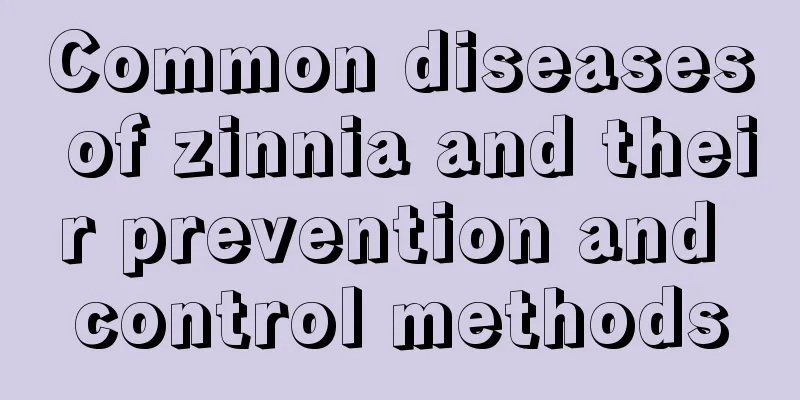Common diseases of zinnia and their prevention and control methods

Common diseases of zinnia: white star diseaseSymptomsDisease on leaves. Initially, small dark brown spots appear, which later become lesions with dark brown edges and grayish white centers, with a diameter of 2-4 mm. The disease mostly occurs on the lower leaves, and in severe cases the leaves curl and wither. There is dark green mold on the surface of the lesion. Prevention and treatment methodsStrengthen management and apply sufficient fertilizer, cultivate strong seedlings, provide shade to prevent rain, water in time after planting, and prevent flooding. Improve greenhouse ventilation and reduce humidity. Remove diseased and damaged parts promptly. In the early stage of the disease, remove the diseased leaves in time and then spray pesticides immediately for prevention and control. You can use 1:0.5:200 Bordeaux mixture plus 0.1% sulfur powder, or 500 times of 65% Zineb wettable powder, or 500-800 times of 75% Thiophanate-methyl wettable powder, or 800-1000 times of 50% Mancozeb. Common diseases of zinnia: black spotSymptomsZinnia black spot disease is also known as brown spot disease. It happens all over the country. The leaves of infected plants turn brown and dry, the petals shrink, and the leaves, stems, and flowers can all be harmed by this disease. Small dark brown spots initially appear on the leaves, which soon expand into large regular spots with a diameter of 2 mm to 10 mm and a reddish brown color. As the spots expand and increase in number, the entire leaf turns brown and dries up. The disease starts at the base of the petiole on the stem and develops longitudinally, becoming dark brown stripes. The symptoms of floral damage are similar to those of leaves, and the petals soon shrink and dry up. During the seedling stage, when the base of the stem is affected, dark brown ulcers with sunken centers are formed. The spots gradually surround the stem, causing the seedlings to show symptoms of damping-off disease. Prevention and treatment methodsSeeds must be disinfected before sowing (use 1000 times diluted 50% carbendazim wettable powder to soak the seeds for 10 minutes). After autumn, diseased leaves, diseased stems, etc. are destroyed in batches to eliminate the source of infection for the next year. Save seeds from healthy, disease-free mother plants. Spray with 50% Zineb or 5000 times diluted Mancozeb. When spraying, pay special attention to spraying evenly on the back of the leaves. Common diseases of zinnia: mosaic diseaseSymptomsIt occurs all over the country, often causing plants to be stunted and degenerate. In the early stages of the disease, the leaves appear slightly mottled, which later develops into light or dark green mottled disease. Symptoms are more obvious on new leaves. Prevention and treatment methodsKilling aphids and preventing diseases has a certain control effect on zinnia mosaic disease. We should also pay attention to field hygiene management and eradicate diseased plants to reduce sources of infection. |
<<: Common diseases and pests of Prunus mume and their control methods
>>: What diseases does Hylocereus spp.
Recommend
Do mulberry trees prefer shade or sun?
Do mulberry trees prefer shade or sun? Mulberry t...
How to grow pennywort? Is pennywort easy to grow?
1. Suitable soil The requirements of the pennywor...
Disease and insect pest control of onion
The main diseases and pests that may occur in dee...
If you don't know how to water your flowers, they will die in a minute.
Drought tolerant plants Money Tree Because the mo...
Can Desert Rose be planted in the ground?
Can Desert Rose be planted in the ground? Desert ...
How to care for Anthurium at home
Anthurium growing conditions Anthurium likes a wa...
How to dwarf black pine
1. Bend the main branches Generally speaking, it ...
How to grow lavender, lavender seed planting method
1. Planting time Lavender is usually planted in s...
Does hibiscus prefer shade or sun?
Does hibiscus prefer shade or sun? Hibiscus is ve...
How long is the growth cycle of star anise?
Introduction to Star Anise Growth Star anise pref...
Why is autumn the best time to transplant peonies? (What season is suitable for planting peonies?)
Spring is not suitable for planting peonies Peony...
When do the flowers bloom?
1. Morning Glory The flowering period of morning ...
How to plant loquat seeds
1. Planting method 1. Select the core: The loquat...
How to drink monk fruit in water, what are the effects and contraindications
1. Soaking method When soaking in water, first se...
Rotten roots, yellow leaves and no growth? My sister told me this method, the leaves are super green and the roots are strong!
1. Chlorophytum comosum Although spider plants ar...









